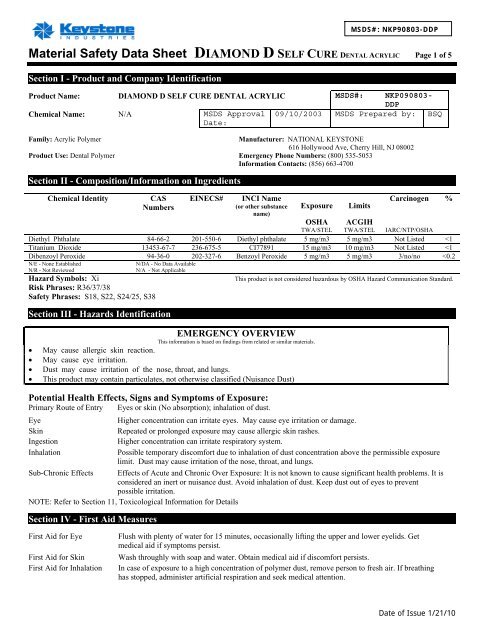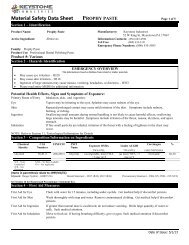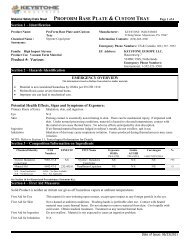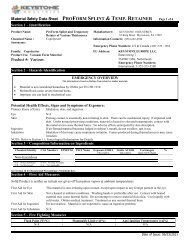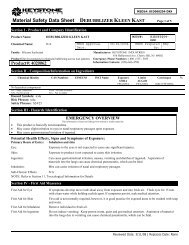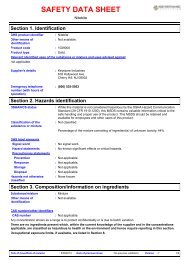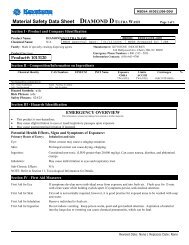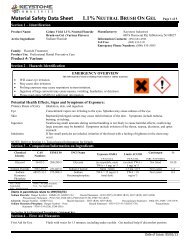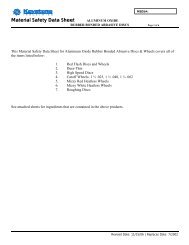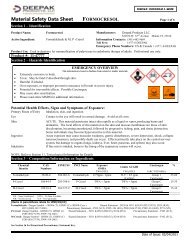Diamond D Self Cure Acrylic 1-10.pdf - Keystone Industries
Diamond D Self Cure Acrylic 1-10.pdf - Keystone Industries
Diamond D Self Cure Acrylic 1-10.pdf - Keystone Industries
You also want an ePaper? Increase the reach of your titles
YUMPU automatically turns print PDFs into web optimized ePapers that Google loves.
MSDS#: NKP90803-DDP<br />
Material Safety Data Sheet DIAMOND D SELF CURE DENTAL ACRYLIC Page 1 of 5<br />
Section I - Product and Company Identification<br />
Product Name: DIAMOND D SELF CURE DENTAL ACRYLIC MSDS#: NKP090803-<br />
DDP<br />
Chemical Name: N/A MSDS Approval<br />
Date:<br />
09/10/2003 MSDS Prepared by: BSQ<br />
Family: <strong>Acrylic</strong> Polymer<br />
Manufacturer: NATIONAL KEYSTONE<br />
616 Hollywood Ave, Cherry Hill, NJ 08002<br />
Product Use: Dental Polymer Emergency Phone Numbers: (800) 535-5053<br />
Information Contacts: (856) 663-4700<br />
Section II - Composition/Information on Ingredients<br />
Chemical Identity<br />
CAS<br />
Numbers<br />
EINECS#<br />
INCI Name<br />
(or other substance<br />
name)<br />
Exposure<br />
Limits<br />
Carcinogen %<br />
OSHA ACGIH<br />
TWA/STEL TWA/STEL IARC/NTP/OSHA<br />
Diethyl Phthalate 84-66-2 201-550-6 Diethyl phthalate 5 mg/m3 5 mg/m3 Not Listed
MSDS#: NKP90803-DDP<br />
Material Safety Data Sheet DIAMOND D SELF CURE DENTAL ACRYLIC Page 2 of 5<br />
First Aid for Ingestion<br />
Section V - Fire Fighting Measures<br />
Never give anything by mouth to an unconscious person. Get medial aid. Do NOT induce vomiting. If<br />
conscious and alert, rinse mouth and drink 2 to 4 cupfuls of milk or water.<br />
Flash Point Flammable Limit Auto-ignition Temperature<br />
(°F/°C) (vol%) (vol%)<br />
572ºF/304ºC (Tag Closed Cup)<br />
LEL: 20 g/m 3 (dust cloud)<br />
UEL: N.A.<br />
N/E<br />
Method:<br />
Extinguishing Media:<br />
Fire Fighting<br />
Instructions:<br />
Unusual Hazards:<br />
Water spray, water foam, carbon dioxide, dry chemical.<br />
Avoid extinguishing methods that generate dust clouds. Water streams can disperse dust into<br />
air, producing a fire hazard and possible explosion hazard. Fire-fighters should wear self -<br />
contained breathing apparatus.<br />
Polymer dust is combustible but not easily ignited. The explosive limits of the polymer particles<br />
suspended in air are approximately those of coal dust.<br />
Section VI - Accidental Release Measures<br />
Spill or Release<br />
Procedures<br />
Sweep up to avoid slipping hazard. Keep airborne particulates at a minimum when cleaning up spills.<br />
Section VII - Handling and Storage<br />
Handling<br />
Storage<br />
Explosion Hazard<br />
Observe precautions found on the label. Wash face and hands thoroughly with soap and water<br />
after handling and before eating, drinking or smoking. Avoid prolonged or repeated contact<br />
with skin. Avoid contamination. Use only with adequate ventilation.<br />
Store in cool, dry place away from heat, sparks, flame and direct sunlight. Close container<br />
after each use. Ground all metal containers when transferring. Use explosion-proof equipment<br />
Store away from combustibles and incompatible materials.<br />
Polymer dust is combustible, explosive limits of the polymer particles suspended in air are<br />
approximately those of coal dust.<br />
Section VIII - Exposure Controls / Personal Protective Equipment<br />
Engineering Controls<br />
Use good local exhaust at processing equipment, including buffers, sanders, grinders and<br />
polishers . High temperature processing equipment should be well ventilated. Use explosionproof<br />
equipment.Provide ventilation if necessary to control exposure levels below airborne<br />
exposure limits.<br />
Personal Protective Equipment<br />
General<br />
Dust collectors are recommended for handling powder in bulk.<br />
To identify additional Personal Protective Equipment (PPE) requirements, it is recommended that a<br />
hazard assessment in accordance with the OSHA PPE Standard (29CFR1910.132), or European<br />
Standard EN166 be conducted before using this product. Provide eye wash stations and safety<br />
showers.<br />
Eye/ Face Protection Use safety glasses and have eye flushing equipment immediately available.<br />
Skin Protection<br />
Respiratory Protection<br />
Minimize contamination by following good industrial practice. Although waering gloves is an<br />
option, wearing nitrile, neoprene, pvc, latex or other impermeable gloves is recommended.<br />
A NIOSH/MSHA approved air purifying respirator with a minimum rating of N95 may be permissible<br />
under certain limited circumstances where airborne concentrations are expected to exceed exsposure<br />
limits. Protection provided by air purifying respirators is limited. Wear a NIOSH/MSHA or European<br />
Standard EN 149 approved full-facepeice airline respirator in the positive pressure mode with<br />
Date of Issue 1/21/10
MSDS#: NKP90803-DDP<br />
Material Safety Data Sheet DIAMOND D SELF CURE DENTAL ACRYLIC Page 3 of 5<br />
emergency escape provisions. Follow OSHA repsirator regulations found in 29 CFR 1910.134 or<br />
Eurpean Standard EN 149.<br />
Section IX - Physical and Chemical Properties<br />
Appearance Odor & Odor Threshold PH Specific Gravity Viscosity % Volatile<br />
Clear, pink, or reddishpink<br />
Faint odor in bulk. N/A N/A N/A 0.0<br />
free flowing<br />
powder<br />
Boiling Point/ Decomposition Octanol/Water Vapor Vapor Evaporation Ignition Solubility<br />
Freezing Point Temperature Partitioning<br />
Coefficient<br />
Pressure: Density Rate In Water<br />
(20°C)<br />
Log Po/w<br />
N/A 392ºF/200ºC N/A N/A N/A N/A N/A insoluble<br />
Flash Point Flammable Limit Auto-ignition Temperature<br />
(°F/°C) (vol%) (vol%)<br />
580ºF/304ºC (Tag Closed Cup)<br />
LEL: 20 g/m 3 (dust cloud)<br />
UEL: N.A.<br />
N/E<br />
Section X - Stability and Reactivity<br />
Stability:<br />
Stable<br />
Hazardous Decomposition Products:<br />
Methyl methacrylate monomers and Carbon Dioxide<br />
Conditions to Avoid:<br />
Heating above 200ºC/392ºF<br />
Incompatibility (Materials to Avoid):<br />
Strong oxidizing agents<br />
Hazardous Polymerization:<br />
will not occur<br />
Section XI - Toxicological Information<br />
Acute Oral Toxicity Acute Dermal Toxicity Acute Inhalation Toxicity Irritation - skin Irritation - Eye<br />
N/DA N/DA N/DA mild mild<br />
Sensitization Mutagenicity Sub-chronic Toxicity<br />
N/DA None None<br />
Section XII - Ecological Information<br />
Ecotoxicological Information<br />
Acute Toxicity<br />
Acute Toxicity Acute Toxicity Bioconcentration Toxicity to Sewage Bacteria<br />
to Fish<br />
to Invertebrates<br />
to Algae<br />
N/DA N/DA N/DA N/DA N/DA<br />
Chemical Fate Information<br />
Biodegradability<br />
Chemical Oxygen Demand<br />
N/DA<br />
N/DA<br />
Section XIII - Disposable Considerations<br />
May be disposed of in a landfill or incinerated. Follow Federal, State and Local regulations for disposal.<br />
Section XIV - Transport Information<br />
DOT (49 CFR 172)<br />
Proper Shipping Name:<br />
Identification Number:<br />
Marine Pollutant:<br />
Non-Regulated Material<br />
N/A<br />
No<br />
Date of Issue 1/21/10
MSDS#: NKP90803-DDP<br />
Material Safety Data Sheet DIAMOND D SELF CURE DENTAL ACRYLIC Page 4 of 5<br />
Special Provisions:<br />
Emergency Response Guidebook (ERG) #:<br />
IATA (DGR):<br />
Proper Shipping Name:<br />
N/A<br />
N/A<br />
Non-Regulated Material<br />
Class or Division:<br />
UN or ID Number:<br />
Packaging Instructions:<br />
Emergency Response Guidance (ICAO)#:<br />
IMO (IMDG):<br />
Proper Shipping Name:<br />
N/A<br />
N/A<br />
Non-Regulated Material<br />
Class or Division:<br />
N/A<br />
UN or ID Number:<br />
N/A<br />
Special Provisions & Stowage/Segregation:<br />
None<br />
Emergency Schedule (EmS)#:<br />
Other Information: Flash point > 100ºC<br />
Section XV - Regulatory Information<br />
US Federal Regulations<br />
Clean Air Act: HAP/ODS<br />
Clean Water Act: Priority Pollutant<br />
FDA: Food Packaging Status<br />
Occupational Safety and Health Act<br />
RCRA<br />
SARA Title III: Section 302<br />
SARA Title III: Section 304<br />
SARA Title III: Section 311-312:<br />
This product contains the following hazardous air pollutants (HAP's) or ozone dipleting<br />
substances (ODS's), as defined by the U. S. Clean Air Act:<br />
• NONE<br />
This product contains the following chemicals listed under the U.S. Clean Water Act<br />
Priority Pollutant List:<br />
• Diethyl phthalate, CAS# 84-66-2<br />
None of the chemicals are listed as a Toxic Pollutant under the CWA.<br />
This product has not been cleared by the FDA for use in food packaging and/ or<br />
other applications as an indirect food additive.<br />
This product is not considered a hazardous chemical under the OSHA Hazard<br />
Communication Standard.<br />
This product contains the following chemicals considered to be hazardous waste under<br />
RCRA (40 CFR 261):<br />
• Diethyl phthalate, CAS# 84-66-2, RCRA Code: U088<br />
This product contains the following chemicals regulated under Sec. 302 as extremely<br />
hazardous substances:<br />
• Diethyl phthalate, CAS#: 84-66-2, RQ= 1000 lbs. (454 kg)<br />
This product contains no chemicals regulated under Sec. 304 as extremely hazardous<br />
chemicals for emergency release notification ("CERCLA" List).<br />
This product does not contain hazardous substances under the OSHA Hazard<br />
Communication Standard, and is not regulated under Section 311-312 (40 CFR 370).<br />
SARA Title III: Section 313: This product contains the following chemicals outlined in SARA Title III: Section 313:<br />
• Benzoyl Peroxide CAS #94-36-0.<br />
TSCA Section 8(b): Inventory: This product contains chemicals listed on the TSCA inventory or otherwise<br />
complies with TSCA premanufacture notification requirements.<br />
State Regulations<br />
CA Right-to-Know Law: Benzoyl Peroxide CAS #94-36-0, Diethyl phthalate CAS# 84-66-2<br />
MA Right-to-Know Law: Benzoyl Peroxide CAS #94-36-0, Diethyl phthalate CAS# 84-66-2<br />
NJ Right-to-Know Law: Benzoyl Peroxide CAS #94-36-0, Diethyl phthalate CAS# 84-66-2<br />
PA Right-to-Know Law: Benzoyl Peroxide CAS #94-36-0, Diethyl phthalate CAS# 84-66-2<br />
Date of Issue 1/21/10
MSDS#: NKP90803-DDP<br />
Material Safety Data Sheet DIAMOND D SELF CURE DENTAL ACRYLIC Page 5 of 5<br />
FL Right-to-Know Law: Benzoyl Peroxide CAS #94-36-0, Diethyl phthalate CAS# 84-66-2<br />
MN Right-to-Know Law: Benzoyl Peroxide CAS #94-36-0, Diethyl phthalate CAS# 84-66-2<br />
International Regulations<br />
CDSL: Canadian Inventory<br />
(on Canadian Transitional List)<br />
EINECS: European Inventory:<br />
Benzoyl Peroxide, CAS# 94-36-0 is on the DSL list. WHMIS = C, D2B, B4<br />
Diethyl phthalate, CAS# 84-66-2 is on the DSL list, WHMIS = n/da<br />
Titanium dioxide, CAS# 13463-67-7 is not on the DSL list.<br />
<strong>Diamond</strong> D <strong>Self</strong> <strong>Cure</strong> Dental <strong>Acrylic</strong>:<br />
• HAZARD SYMBOLS: Xi: Irritant<br />
• RISK PHRASES: R36/37/38: Irritating to eyes, respiratory system and skin<br />
• SAFETY PHRASES: S18: Handle and open container with care, S22: do not<br />
breath dust, S24/25: avoid contact with skin and eyes, S38: in case of<br />
insufficient ventilation, wear suitable respiratory equipment.<br />
Section XVI - Other Information<br />
Hazard Rating System (Pictograms)<br />
NFPA:<br />
1<br />
Flammability<br />
HMIS:<br />
1<br />
1<br />
Health<br />
D<br />
1<br />
Reactivity<br />
1<br />
1<br />
* - Respiratory protection may be necessary depending on conditions of use. Refer to Section VIII of this MSDS for respiratory<br />
protection guidelines.<br />
Approval Date: 9/08/2003<br />
Supersedes Date: Initial Issue<br />
OSHA PEL for nuisance dust: 15 mg/m 3 (total dust)<br />
5 mg/m 3 (respirable dust)<br />
ACGIH PEL for nuisance dust: 10 mg/m 3<br />
*D<br />
Product Number -<br />
Revised Sections since Last Version:<br />
Initial Issue<br />
1/21/2010 Section IX updated appearance as MSDS covers various colors SWR<br />
The information presented herein was obtained from sources considered to be reliable. However, this information is provided without<br />
any warranty, expressed or implied, regarding its correctness or suitability for consumers intended use and/or application. For this and<br />
other reasons, we assume no responsibility and expressly disclaim liability for loss, damage or expense arising out of any way<br />
connected with the handling, storage, use or disposal of the product. This MSDS was prepared expressly for this product. Use the<br />
materials only as directed. If the product is used as a component of another product, the information contained within the MSDS may<br />
not be applicable. If one could have any concerns with or problems understanding this MSDS form, please direct all questions to<br />
INFOTRAC, Chemical Emergency Resources System at 1(800) 535-5053.<br />
Date of Issue 1/21/10


